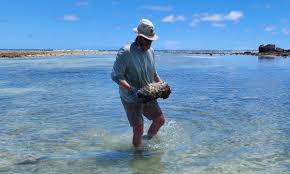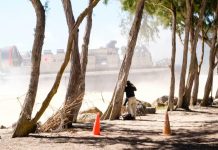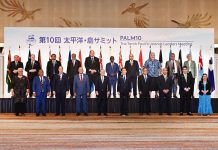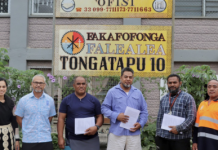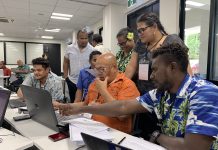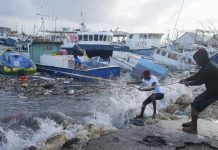By Jon Letman
The Marshall Islands is a nation of atolls – hundreds of small islands carpeted in coconut palms and pandanus trees. While these atolls in the Pacific Ocean are a picture of tropical beauty, they are also home to explosive remnants of war.
Eight decades after the guns fell silent, munitions left by the U.S and Japan still litter beaches, jungles, and lagoons and continue to pose a hidden but lethal threat.
Now millions is being spent by the U.S and others across the Pacific to identify, remove and destroy dormant bombs, also known as unexploded ordnance. Some estimate the number of bombs – found across the region including in Fiji, Palau and Solomon Islands – could be in the hundreds of thousands.
If the fusing mechanism is intact, unexploded bombs can still detonate if disturbed.
“Every now and then people find these explosives on the surface of the land,” says Rithen Lajar, mayor of Wotje, an atoll in the Marshall Islands.
While the threat has existed for decades, Lajar wants more to be done by the US and Japan to give farmers the ability to plant crops, build new facilities for the community and give people a greater sense of security.
“We want all these bombs to be taken from our land right away so we can live our lives.”
Protecting the land of legend
Northern Michigan University researcher Ruth Abbott analysed U.S bombing surveys from 1945 and found America dropped 12,918 tons of ordnance on four Marshall Islands atolls during the second world war.
After so many years, partially exposed bombs – or suspected bombs – have been identified in the community but attempting to move them can be deadly.
In 2023, the U.S state department launched a US$1.7m project with not-for-profit Golden West Humanitarian Foundation to remove unexploded bombs on four atolls prioritised by the Marshall Islands government. California-based Golden West employs military veterans specialising in ordnance disposal, training and weapons clearing technology.
In September, a team travelled to Maloelap Atoll to recover and destroy unexploded ordnances. They plan to conduct another mission next month. Adan Morones, Golden West’s Marshall Islands project manager, is a former U.S marine and a veteran of the Iraq and Afghanistan wars. He says extensive planning and coordination is needed to deliver the necessary vehicles, generators and supplies to remote islands.
Once they reach the atoll, the team is guided by locals familiar with contaminated sites. When an explosive requires detonation, the team will choose a safe disposal location and clear the area.
Marshall Islands resident Wilbert Alik has played a crucial role in the clean-up effort. Alik, director of the Marshall Islands Cultural and Historic Preservation office, acts as interpreter, community adviser and government liaison, accompanying Golden West’s team to each atoll.
He explains how he works with technicians to ensure safety protocols are followed and that important cultural and historical sites aren’t damaged.
“For us Marshallese, there are lots of sites that could be just two or three palm trees that are growing there but that property associates with a legend,” Alik says from the capital Majuro.
“Like Native Americans, there are lots of these geographical features that are very meaningful,” he says.
Next month Alik, Morones and his team will spend three weeks on Wotje clearing unexploded ordnance. As a former Japanese seaplane base, Wotje is dotted with ruins of concrete bunkers and crumbling structures overgrown with roots and vines.
Over generations, Wotje residents have grown accustomed to being cautious when planting crops, gathering medicinal plants, or even walking in the forest. They know a dormant baaṃ (bomb) could be buried in the sand or obscured by foliage.
Alik says the threat of accidentally striking an unexploded ordnance is especially high for residents who process copra – the dried flesh of coconuts. The risk rises for farmers digging smoke pits needed for making copra. Attempts to reduce the dangers are being made with risk education offered at community gatherings in local churches in parts of the Marshall Islands, teaching people how to recognise and avoid hidden bombs. The team also trains local police to document suspected bomb sites using GPS.
‘Every bullet is one less to deal with’
Still, the training has not yet reached all communities that are exposed to the risk of unexploded ordnance. There is no official tally of deaths or injuries by the bombs but reports of fatalities include a woman killed on Mili Atoll when she struck a hidden bomb while digging a cooking pit in 2016.
Golden West president Allan Vosburgh estimates the number of unexploded ordnances throughout the Pacific to be in the hundreds of thousands. Last year, the group says it disposed of 43 bombs and projectiles on Maloelap Atoll. After the clearance and disposal on Wotje next month, they will move on to Jaluit Atoll in 2025 and Mili Atoll in 2026. Between 2020 and 2023, the U.S provided US$8.1m in assistance to dispose of unexploded bombs in the Marshall Islands, Fiji, Palau, and Solomon Islands.
“I’ve been doing this for more than 50 years and I’m never going to run out of work,” says Vosburgh.
“I’m 76 and I foresee this outliving me by a long shot. But I do think we can make a lot of difference in the Pacific because in places where they’re no longer shooting, every round that you clean up, every bullet you pick up is one less that you’ve got to deal with.”
As Wotje’s mayor, one of Lajar’s goals is to see his atoll cleared of unexploded ordnance so that people can feel safe enough to create the places needed to enjoy their lives.
“We need to build community places,” Lajar says. “A gym, schools, that’s what we need.”.






